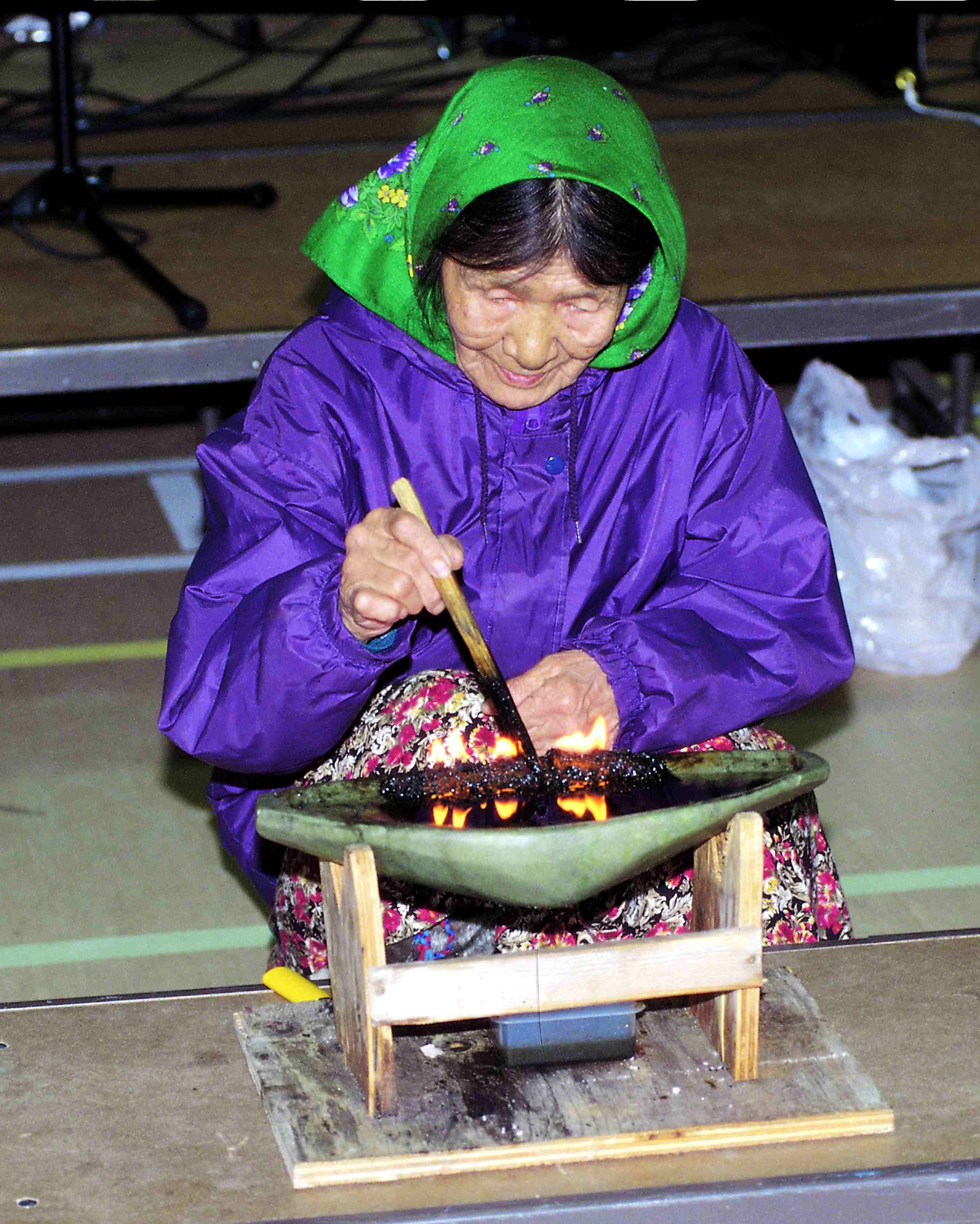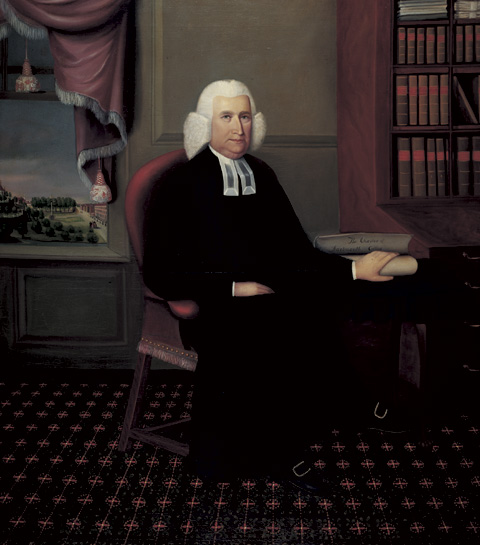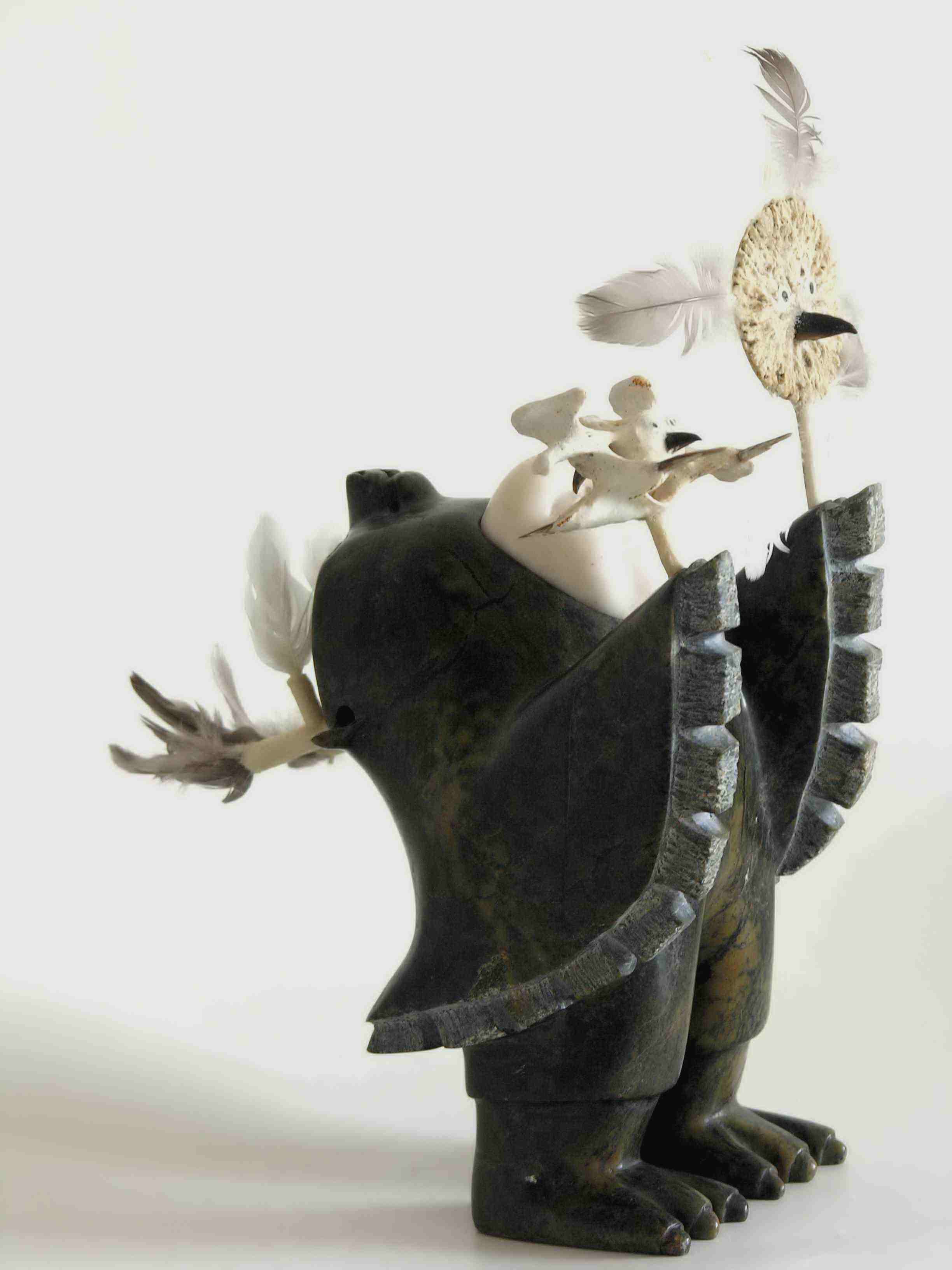|
Avataq Cultural Institute
The Avataq Cultural Institute is Nunavik's official organization for the preservation and promotion of the Inuktitut language and Inuit culture. Avataq has departments that deal with ethnography and art, as well as a library, archive and language programs. History Avataq receives its mandate from the biennial Inuit Elders Conference. The Institute was formed at the first Inuit Elders Conference with the goal of protecting Inuit culture. It began operating on November 1, 1980. Its head office is in Inukjuak and it also operates an office in Montreal, Quebec. In 1984 Avataq supported a place-name survey of elders in 12 Inuit communities in the Quebec Arctic. Activities In 2018 Avataq worked with Dartmouth College to return bones that had been excavated from Inuit gravesites in 1967 by one of the college's anthropologists. The Institute formed an alliance with the Montreal Museum of Fine Arts in 2018 to promote Inuit art Inuit art, also known as Eskimo art, refers to artwork prod ... [...More Info...] [...Related Items...] OR: [Wikipedia] [Google] [Baidu] |
Nunavik
Nunavik (; ; iu, ᓄᓇᕕᒃ) comprises the northern third of the province of Quebec, part of the Nord-du-Québec region and nearly coterminous with Kativik. Covering a land area of north of the 55th parallel, it is the homeland of the Inuit of Quebec and part of the wider Inuit Nunangat. Almost all of the 14,045 inhabitants ( 2021 census) of the region, of whom 90% are Inuit, live in fourteen northern villages on the coast of Nunavik and in the Cree reserved land (TC) of Whapmagoostui, near the northern village of Kuujjuarapik. means "great land" in the local dialect of Inuktitut and the Inuit inhabitants of the region call themselves . Until 1912, the region was part of the District of Ungava of the Northwest Territories. Negotiations for regional autonomy and resolution of outstanding land claims took place in the 2000s. The seat of government would be Kuujjuaq. Negotiations on better empowering Inuit political rights in their land are still ongoing. A flag for N ... [...More Info...] [...Related Items...] OR: [Wikipedia] [Google] [Baidu] |
Inuktitut
Inuktitut (; , syllabics ; from , "person" + , "like", "in the manner of"), also Eastern Canadian Inuktitut, is one of the principal Inuit languages of Canada. It is spoken in all areas north of the tree line, including parts of the provinces of Newfoundland and Labrador, Quebec, to some extent in northeastern Manitoba as well as the Northwest Territories and Nunavut. It is one of the aboriginal languages written with Canadian Aboriginal syllabics. It is recognised as an official language in Nunavut alongside Inuinnaqtun, and both languages are known collectively as ''Inuktut''. Further, it is recognized as one of eight official native tongues in the Northwest Territories. It also has legal recognition in Nunavik—a part of Quebec—thanks in part to the James Bay and Northern Quebec Agreement, and is recognised in the Charter of the French Language as the official language of instruction for Inuit school districts there. It also has some recognition in Nunatsiavut—the Inui ... [...More Info...] [...Related Items...] OR: [Wikipedia] [Google] [Baidu] |
Inuit Culture
The Inuit are an indigenous people of the Arctic and subarctic regions of North America (parts of Alaska, Canada, and Greenland). The ancestors of the present-day Inuit are culturally related to Iñupiat (northern Alaska), and Yupik (Siberia and western Alaska), and the Aleut who live in the Aleutian Islands of Siberia and Alaska. The term culture of the Inuit, therefore, refers primarily to these areas; however, parallels to other Eskimo groups can also be drawn. The word " Eskimo" has been used to encompass the Inuit and Yupik, and other indigenous Alaskan and Siberian peoples, but this usage is in decline. Various groups of Inuit in Canada live throughout the Inuvialuit Settlement Region of the Northwest Territories, the territory of Nunavut, Nunavik in northern Quebec and Nunatsiavut in Labrador and the unrecognised area known as NunatuKavut. With the exception of NunatuKavut these areas are sometimes known as Inuit Nunangat. The traditional lifestyle of the Inuit i ... [...More Info...] [...Related Items...] OR: [Wikipedia] [Google] [Baidu] |
Inukjuak
Inukjuak ( iu, ᐃᓄᒃᔪᐊᒃ, ''Inujjuaq'' or ''Inukjuaq'' in Latin script, meaning 'The Giant') is a northern village (Inuit community) located on Hudson Bay at the mouth of the Innuksuak River in Nunavik, in the region of northern Quebec, Canada. Its population is 1,821 as of the 2021 Canadian Census. An older spelling is ; its former name was Port Harrison. It is not accessible by road, but by boat in summer and year-round by air through Inukjuak Airport. The police services for Inukjuak are provided by the Kativik Regional Police Force, which has one police station in the village. 'The Giant' is the literal translation of the word Inukjuak, but originally it was Inurjuat, which means "many people". In the past there was an Inuk (singular for the word Inuit) who went down to the river of Inukjuak to fetch some water. While there, the person saw many Inuit in kayaks approaching from the mouth of the river, and then yelled back out to the community "". That is where t ... [...More Info...] [...Related Items...] OR: [Wikipedia] [Google] [Baidu] |
Montreal
Montreal ( ; officially Montréal, ) is the List of the largest municipalities in Canada by population, second-most populous city in Canada and List of towns in Quebec, most populous city in the Provinces and territories of Canada, Canadian province of Quebec. Founded in 1642 as ''Fort Ville-Marie, Ville-Marie'', or "City of Mary", it is named after Mount Royal, the triple-peaked hill around which the early city of Ville-Marie is built. The city is centred on the Island of Montreal, which obtained its name from the same origin as the city, and a few much smaller peripheral islands, the largest of which is Île Bizard. The city is east of the national capital Ottawa, and southwest of the provincial capital, Quebec City. As of 2021, the city had a population of 1,762,949, and a Census Metropolitan Area#Census metropolitan areas, metropolitan population of 4,291,732, making it the List of the largest municipalities in Canada by population, second-largest city, and List of cen ... [...More Info...] [...Related Items...] OR: [Wikipedia] [Google] [Baidu] |
Quebec
Quebec ( ; )According to the Canadian government, ''Québec'' (with the acute accent) is the official name in Canadian French and ''Quebec'' (without the accent) is the province's official name in Canadian English is one of the thirteen provinces and territories of Canada. It is the largest province by area and the second-largest by population. Much of the population lives in urban areas along the St. Lawrence River, between the most populous city, Montreal, and the provincial capital, Quebec City. Quebec is the home of the Québécois nation. Located in Central Canada, the province shares land borders with Ontario to the west, Newfoundland and Labrador to the northeast, New Brunswick to the southeast, and a coastal border with Nunavut; in the south it borders Maine, New Hampshire, Vermont, and New York in the United States. Between 1534 and 1763, Quebec was called ''Canada'' and was the most developed colony in New France. Following the Seven Years' War, Quebec b ... [...More Info...] [...Related Items...] OR: [Wikipedia] [Google] [Baidu] |
Inuit
Inuit (; iu, ᐃᓄᐃᑦ 'the people', singular: Inuk, , dual: Inuuk, ) are a group of culturally similar indigenous peoples inhabiting the Arctic and subarctic regions of Greenland, Labrador, Quebec, Nunavut, the Northwest Territories, and Alaska. Inuit languages are part of the Eskimo–Aleut languages, also known as Inuit-Yupik-Unangan, and also as Eskaleut. Inuit Sign Language is a critically endangered language isolate used in Nunavut. Inuit live throughout most of Northern Canada in the territory of Nunavut, Nunavik in the northern third of Quebec, Nunatsiavut and NunatuKavut in Labrador, and in various parts of the Northwest Territories, particularly around the Arctic Ocean, in the Inuvialuit Settlement Region. With the exception of NunatuKavut, these areas are known, primarily by Inuit Tapiriit Kanatami, as Inuit Nunangat. In Canada, sections 25 and 35 of the Constitution Act of 1982 classify Inuit as a distinctive group of Aboriginal Canadians wh ... [...More Info...] [...Related Items...] OR: [Wikipedia] [Google] [Baidu] |
Dartmouth College
Dartmouth College (; ) is a private research university in Hanover, New Hampshire. Established in 1769 by Eleazar Wheelock, it is one of the nine colonial colleges chartered before the American Revolution. Although founded to educate Native Americans in Christian theology and the English way of life, the university primarily trained Congregationalist ministers during its early history before it gradually secularized, emerging at the turn of the 20th century from relative obscurity into national prominence. It is a member of the Ivy League. Following a liberal arts curriculum, Dartmouth provides undergraduate instruction in 40 academic departments and interdisciplinary programs, including 60 majors in the humanities, social sciences, natural sciences, and engineering, and enables students to design specialized concentrations or engage in dual degree programs. In addition to the undergraduate faculty of arts and sciences, Dartmouth has four professional and graduate schools: ... [...More Info...] [...Related Items...] OR: [Wikipedia] [Google] [Baidu] |
Anthropologist
An anthropologist is a person engaged in the practice of anthropology. Anthropology is the study of aspects of humans within past and present societies. Social anthropology, cultural anthropology and philosophical anthropology study the norms and values of societies. Linguistic anthropology studies how language affects social life, while economic anthropology studies human economic behavior. Biological (physical), forensic and medical anthropology study the biological development of humans, the application of biological anthropology in a legal setting and the study of diseases and their impacts on humans over time, respectively. Education Anthropologists usually cover a breadth of topics within anthropology in their undergraduate education and then proceed to specialize in topics of their own choice at the graduate level. In some universities, a qualifying exam serves to test both the breadth and depth of a student's understanding of anthropology; the students who pass are pe ... [...More Info...] [...Related Items...] OR: [Wikipedia] [Google] [Baidu] |
Montreal Museum Of Fine Arts
The Montreal Museum of Fine Arts (MMFA; french: Musée des beaux-arts de Montréal, MBAM) is an art museum in Montreal, Quebec, Canada. It is the largest art museum in Canada by gallery space. The museum is located on the historic Golden Square Mile stretch of Sherbrooke Street. The MMFA is spread across five pavilions, and occupies a total floor area of , 13,000 () of which are exhibition space. With the 2016 inauguration of the Michal and Renata Hornstein Pavilion for Peace, the museum campus was expected to become the eighteenth largest art museum in North America. The permanent collection included approximately 44,000 works in 2013. The original "reading room" of the Art Association of Montreal was the precursor of the museum's current library, the oldest art library in Canada.MMFA Library The Montreal Museum of Fine Arts is a member of ... [...More Info...] [...Related Items...] OR: [Wikipedia] [Google] [Baidu] |
Inuit Art
Inuit art, also known as Eskimo art, refers to artwork produced by Inuit, that is, the people of the Arctic previously known as Eskimos, a term that is now often considered offensive. Historically, their preferred medium was walrus ivory, but since the establishment of southern markets for Inuit art in 1945, prints and figurative works carved in relatively soft stone such as soapstone, serpentinite, or argillite have also become popular. The Winnipeg Art Gallery has the largest public collection of contemporary Inuit art in the world. In 2007, the Museum of Inuit Art opened in Toronto, but closed due to lack of resources in 2016. History Pre-Dorset and Dorset cultures Around 4000 BCE nomads known as the Pre-Dorset or the Arctic small tool tradition (ASTT) crossed over the Bering Strait from Siberia into Alaska, the Canadian Arctic, Greenland, and Labrador. Very little remains of them, and only a few preserved artifacts carved in ivory could be considered works of art. The ... [...More Info...] [...Related Items...] OR: [Wikipedia] [Google] [Baidu] |
Inuit Languages
The Inuit languages are a closely related group of indigenous American languages traditionally spoken across the North American Arctic and adjacent subarctic, reaching farthest south in Labrador. The related Yupik languages (spoken in western and southern Alaska, as well as in nearby Russia's farthest east, though severely endangered there) are the two main branches of Eskaleut, a primary language family. The Inuit live primarily in three countries: Greenland (Kingdom of Denmark), Canada (specifically in Nunavut, Northwest Territories, the Nunavik region of Quebec, and the Nunatsiavut and Nunatuĸavut regions of Labrador), and the United States (specifically the coast of Alaska). The total population of Inuit speaking their traditional languages is difficult to assess with precision, since most counts rely on self-reported census data that may not accurately reflect usage or competence. Greenland census estimates place the number of speakers of varieties of Inuit languages th ... [...More Info...] [...Related Items...] OR: [Wikipedia] [Google] [Baidu] |





